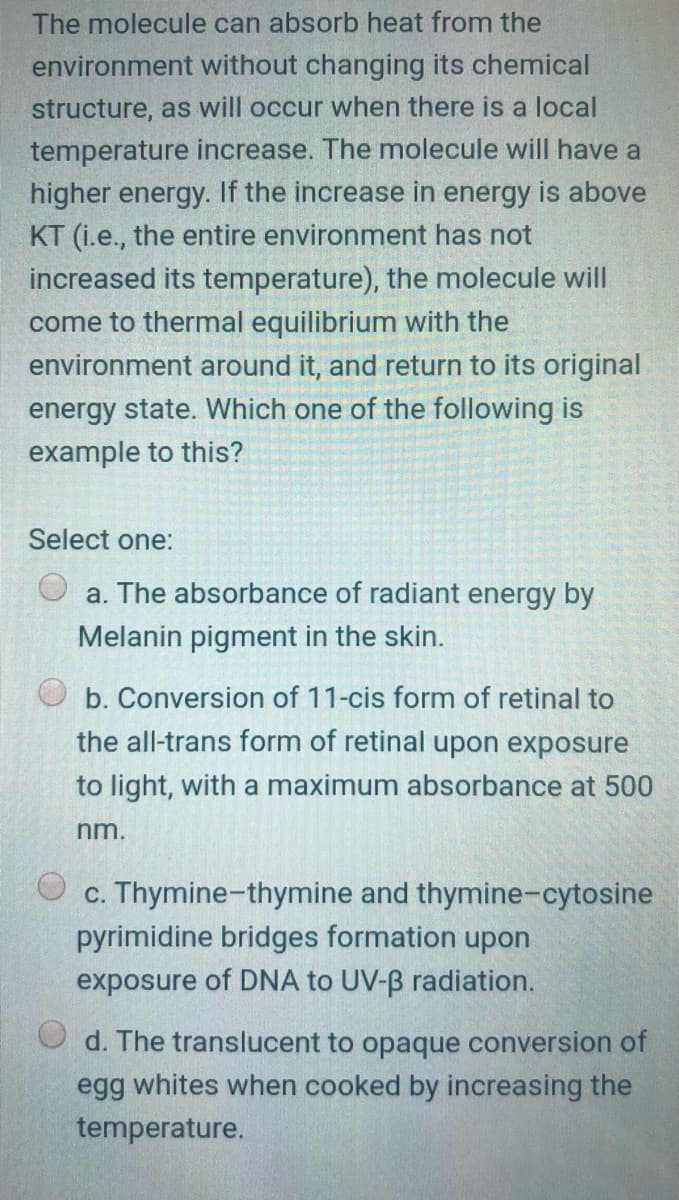The molecule can absorb heat from the environment without changing its chemical structure, as will occur when there is a local temperature increase. The molecule will have a higher energy. If the increase in energy is above KT (i.e., the entire environment has not increased its temperature), the molecule will come to thermal equilibrium with the environment around it, and return to its original energy state. Which one of the following is example to this? Select one: a. The absorbance of radiant energy by Melanin pigment in the skin. b. Conversion of 11-cis form of retinal to the all-trans form of retinal upon exposure to light, with a maximum absorbance at 500 nm. c. Thymine-thymine and thymine-cytosine pyrimidine bridges formation upon exposure of DNA to UV-B radiation. d. The translucent to opaque conversion of egg whites when cooked by increasing the temperature.
The molecule can absorb heat from the environment without changing its chemical structure, as will occur when there is a local temperature increase. The molecule will have a higher energy. If the increase in energy is above KT (i.e., the entire environment has not increased its temperature), the molecule will come to thermal equilibrium with the environment around it, and return to its original energy state. Which one of the following is example to this? Select one: a. The absorbance of radiant energy by Melanin pigment in the skin. b. Conversion of 11-cis form of retinal to the all-trans form of retinal upon exposure to light, with a maximum absorbance at 500 nm. c. Thymine-thymine and thymine-cytosine pyrimidine bridges formation upon exposure of DNA to UV-B radiation. d. The translucent to opaque conversion of egg whites when cooked by increasing the temperature.
Biology Today and Tomorrow without Physiology (MindTap Course List)
5th Edition
ISBN:9781305117396
Author:Cecie Starr, Christine Evers, Lisa Starr
Publisher:Cecie Starr, Christine Evers, Lisa Starr
Chapter13: Early Life Forms And The Viruses
Section: Chapter Questions
Problem 3SQ
Related questions
Question
100%

Transcribed Image Text:The molecule can absorb heat from the
environment without changing its chemical
structure, as will occur when there is a local
temperature increase. The molecule will have a
higher energy. If the increase in energy is above
KT (i.e., the entire environment has not
increased its temperature), the molecule will
come to thermal equilibrium with the
environment around it, and return to its original
energy state. Which one of the following is
example to this?
Select one:
a. The absorbance of radiant energy by
Melanin pigment in the skin.
b. Conversion of 11-cis form of retinal to
the all-trans form of retinal upon exposure
to light, with a maximum absorbance at 500
nm.
c. Thymine-thymine and thymine-cytosine
pyrimidine bridges formation upon
exposure of DNA to UV-B radiation.
d. The translucent to opaque conversion of
egg whites when cooked by increasing the
temperature.
Expert Solution
This question has been solved!
Explore an expertly crafted, step-by-step solution for a thorough understanding of key concepts.
Step by step
Solved in 4 steps

Knowledge Booster
Learn more about
Need a deep-dive on the concept behind this application? Look no further. Learn more about this topic, biochemistry and related others by exploring similar questions and additional content below.Recommended textbooks for you

Biology Today and Tomorrow without Physiology (Mi…
Biology
ISBN:
9781305117396
Author:
Cecie Starr, Christine Evers, Lisa Starr
Publisher:
Cengage Learning

Anatomy & Physiology
Biology
ISBN:
9781938168130
Author:
Kelly A. Young, James A. Wise, Peter DeSaix, Dean H. Kruse, Brandon Poe, Eddie Johnson, Jody E. Johnson, Oksana Korol, J. Gordon Betts, Mark Womble
Publisher:
OpenStax College

Biology Today and Tomorrow without Physiology (Mi…
Biology
ISBN:
9781305117396
Author:
Cecie Starr, Christine Evers, Lisa Starr
Publisher:
Cengage Learning

Anatomy & Physiology
Biology
ISBN:
9781938168130
Author:
Kelly A. Young, James A. Wise, Peter DeSaix, Dean H. Kruse, Brandon Poe, Eddie Johnson, Jody E. Johnson, Oksana Korol, J. Gordon Betts, Mark Womble
Publisher:
OpenStax College